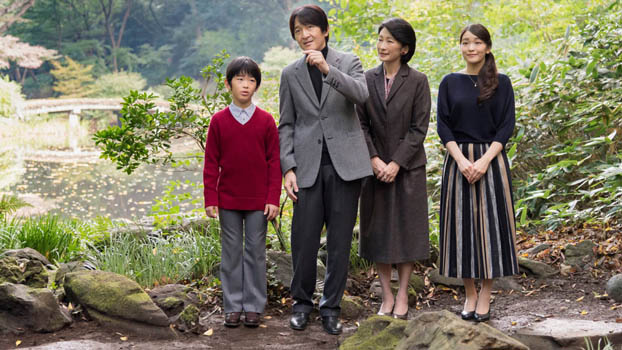Japan’s fragile monarchy
If Japan is going to continue to have an imperial house, it should be one that upholds the principle of gender equality by allo


With Japan moving forward with the formal investiture of Crown Prince Akishino on Sunday — postponed once due to the COVID-19 pandemic — the tremendous fragility of the imperial line has once again come into spotlight.
By all accounts, the crown prince and his wife, Crown Princess Kiko, are decent and sincere individuals who try to use their imperial prestige to make the world a better place. They have, along with Emperor Naruhito, Empress Masako and other imperial family members, continued in the footsteps of the previous emperor and empress by mixing regularly with their countrymen (although it has proven to be difficult amid the pandemic).
Frankly, those in Japan who care deeply about the imperial house should be grateful for the fact that Crown Prince Akishino has gracefully accepted his secondary position.
After all, his position is based on a hereditary system that one would be hard pressed to locate, with such finality in terms of defining a child’s future according to birth order, in other areas of Japanese society in the 21st century.
Although many in Japan have watched with fascination (and probably horror in some quarters) as Prince Harry basically turned his back on a royal life of being second fiddle to his older brother, Prince William, who shall likely inherit the throne, a largely unspoken concern has been, “What if something similar happened in Japan?”
The concern in Japan should be all the more pronounced considering the heir crisis.
As modernity has progressed, it has become increasingly possible to imagine that, at least for some royal family members, the advantages of being born into a royal family do not necessarily outweigh the disadvantages, especially for anyone
other than the child in line to inherit the throne.
Prince Harry’s recent departure from Britain provided concrete evidence for this thesis.
In the case of Japan, frankly there is a world of difference between the emperor and empress and all the other imperial family members. The latter represents the B-team if you will, no offense intended (especially since they owe their positions to birth rather than to a meritocratic system), but that is the reality of the situation.
Add into this equation the fact that Japan’s male-only policy is responsible for the present situation whereby there are presently only two viable heirs to the throne — Crown Prince Akishino and his 14-year old son, Prince Hisahito — and one begins to understand that Japan’s imperial line is potentially quite fragile.
Crown Prince Akishino, 54, is five years younger than his brother the emperor. If he ever ascends to the throne (it is easy to imagine that, depending on when his older brother passes or abdicates, the crown prince might step aside in favor of his son), his reign will likely be short.
But that is somewhat of a footnote compared to the fact that he and Crown Princess Kiko are raising the only male member of the next generation of imperials. It is no exaggeration to say that the future of the imperial line rests on the shoulders of 14-year-old Prince Hisahito.
This easily could be considered a human rights issue if one fleshes out some scenarios that are coming down the road. Consider, for example, the overwhelming pressure that Prince Hisahito and his future spouse will come under to produce a son (and the birth of only one son would mean that the tremendous fragility of the imperial line would continue for another generation).
For more than 25 years, I have researched and written about Japan’s imperial family because it happens to be a tremendously useful window to understanding various aspects of ever-evolving Japan.
At this point, I have written about almost every aspect of the imperial house.
But here in 2020, as women assert themselves worldwide and gender equality becomes a global standard, what stands out more than anything about Japan’s imperial house is the stubborn insistence of the nation’s politicians to maintain the male-only system, even if that means putting the future of the imperial house at risk.
Conservatives continue to trot out the unbroken male bloodline trope (the veracity of which historians who value empirical evidence doubt) as what supposedly makes Japan unique with a capital U, and of course they employ the concept of tradition with great gravity.
Too many people tend to be seduced by the magic attached to the term tradition, so let us conclude here by thinking through the concept of tradition.
First, there is no accepted definition of the concept of tradition (e.g., exactly how long must a practice continue to be considered a tradition?). Throughout history, societies have mulled over the value of various traditions, discarding those that were no longer useful or no longer matched the times.
How can change, indeed progress, happen otherwise?
Japan no longer has the estate system — samurai, farmers, artisans, and merchants — with which it entered the modern world at the time of the Meiji Restoration of 1868.
This is just one example from many candidates to remind Japanese that they have periodically discarded so-called “traditions.”
If Japan is going to continue to have an imperial house, it should be one that upholds the principle of gender equality by allowing regnant empresses.
The secret of Japan’s imperial house’s long survival is not stubborn adherence to tradition, but rather quite the opposite, a willingness to keep in tune with the trends of the time, to shed traditions that no longer suit changing societal norms, and to adopt new practices.
Kenneth Ruoff is director of the Center for Japanese Studies at Portland State University and the author of “Japan’s Imperial House in the Postwar Era, 1945-2019” published earlier this year


